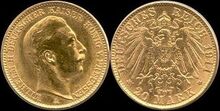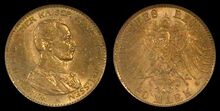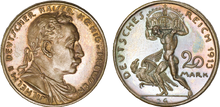
|
This article or section needs to be cleaned up to reach a higher standard of article quality.
Please follow the guidelines of our manual of style and complete this article to a higher level of quality. When this is done, this message may be removed. |
| 20 mark | |||
|---|---|---|---|
 
| |||
| 1914 coin | |||
| General information | |||
| Country | |||
| Value |
ℳ20.00 | ||
| Years |
1871–1915 | ||
| Measurements and composition | |||
| Mass |
7.965 g[1] | ||
| Diameter |
22.5 mm[1] | ||
| Composition | |||
| Appearance | |||
| Shape |
round | ||
| Alignment |
medallic | ||
| Obverse |
| ||
| Reverse |
Reichsadler, state title, value, year[1] | ||
| v · d · e | |||
The 20 mark coin was first issued by the Kingdom of Prussia in 1871[3], during the reign of King/Kaiser William I (Wilhelm I).[4] This initial coin was struck until 1873, and was replaced by a similar issue in 1874.[3] Upon William's death in 1888, Frederick III became King of Prussia[4], and a coin featuring his likeness was struck soon after his reign began.[3] However, Frederick's reign was extremely ephemeral, and his son, William II (Wilhelm II), succeeded him on June 15, 1888[4], and 20 mark coins of the new king commenced issuance that year, and continued to be minted until 1915. Over this span of 27 years, three coin types of William II were made.[3]
History[]
Coins of William I[]
1873 coin of William I
| |

|

|
| Obverse | Reverse |
The first 20 mark coin of the Kingdom of Prussia was issued during the first year of William I's reign as German Emperor, and the 10th year of his reign as King of Prussia[5], in 1871.[3] It had the standard composition and measurements of every 20 gold mark coin issued by the states of the German Empire at the time, having been composed of .900 fine gold, weighing 7.965 grams, and measuring 22.5 millimeters in diameter.[1] A right-facing portrait of William I was engraved in the center of the coin's obverse, partially encircled by a caption reading "WILHELM DEUTSCHER KAISER KÖNIG V. PREUSSEN". Directly underneath the likeness of the king was either an "A", "B", or "C" mint mark, respectively indicating the coin was struck at the Berlin, Hannover, or Frankfurt Mint. The Reichsadler of the German Empire was displayed on the reverse, accompanied by the state title of the Second Reich (DEUTSCHES REICH), an oak branch, the coin's value (as "20 M."), and the year, with the numbers of the date, the inscription of the value, and the state title being separated by the heraldic eagle. The reverse was subsequently altered in 1874, featuring a smaller variant of the Reichsadler that did not separate any text and a new inscription for the value, which now read "20 MARK". In addition, the oak branch present on the first issue was removed. Around the edge of both issues was an inscription reading "GOTT MIT UNS". A total of at least 30,928,158 examples were struck between 1871 and 1873, with at least 2491 being struck in proof quality, while 26,366,736 were minted from 1874 to 1888, excluding the number of proofs, which was not recorded.[2]
Coin of Frederick III[]

Coin of Frederick III
Upon William I's death on March 19, 1888, his only son, Frederick III[5], succeeded him as German Emperor and King of Prussia[4], and a coin featuring his likeness was struck shortly after his reign began.[3] A right-facing effigy of Frederick was engraved on the obverse, accompanied by a caption reading "FRIEDRICH DEUTSCHER KAISER KÖNIG V. PREUSSEN" and an "A" mint mark. It featured the same reverse as the second issue of William I, and also retained the coin's composition and measurements.[2] Frederick's reign was short-lived, and only lasted 99 days before he died of laryngeal cancer on June 15, 1888.[6] As a result, only 5,363,901 examples of the coin, excluding proofs, were issued in 1888.[2]
General issue coins of William II[]

Coin of William II from 1911.
William II (Wilhelm II) succeeded his father, Frederick III, as German Emperor and King of Prussia on June 15, 1888[4], and a 20 mark coin featuring his likeness was issued the year his reign began.[3] It featured a right-facing portrait of William on the obverse, accompanied by an inscription reading "WILHELM II DEUTSCHER KAISER KÖNIG V. PREUSSEN" and an "A" mint mark. The first issue of the new king was only made from 1888 to 1889, with a total mintage of at least 11,640,782, and was soon replaced by a second issue in 1890. Coins of the second issue were nearly identical to those of the first issue, with the reverse being the only altered element. From 1874 to 1889, the Reichsadler present on the reverse of all imperial German coinage was rather small and bore a large shield on its breast. However, in 1890, the heraldic eagle itself became larger and the shield on its breast was reduced in size. The second issue was struck every year from 1890 to 1913. Between these years, a total of at least 152,272,435 examples were minted, with more than 411 being issued in proof quality.[2]

1914 coin of William II.
The third 20 mark coin of King/Kaiser William II was introduced in 1913 and issued until 1915. It featured a right-facing effigy of William wearing a military uniform, partially encircled by a caption reading "WILHELM II DEUTSCHER KAISER KÖNIG VON PREUSSEN". Underneath the likeness of the king was an "A" mint mark. No changes were made regarding the composition, measurements, and reverse design of the previous issue. At least 3,404,916 examples were issued, excluding the number of coins struck in 1913 as well as the total number of proofs issued, two figures that were not recorded.[2]
Pattern coins[]

Karl Goetz pattern
A number of Prussian 20 mark patterns were struck in a variety of compositions by the Berlin Mint. The first pattern minted was a silver or silvered coin of William I from 1878. Two unissued copper coins bearing William II's likeness were later struck in 1890 and 1907, and were accompanied by silver patterns in 1900 and 1901, and a gold pattern in 1908.[3]
German medalist Karl Goetz designed a series of 20 mark pattern coins in 1913 and submitted them to the Berlin Mint. These proof coins were struck in bronze, copper, copper-gilded metal, gold, silver, and silver-gilded metal. The gold and silver coins both weighed 4.2 grams, while the copper coin was slightly heavier, with a mass of 4.24 grams. A right-facing effigy of King/Kaiser William II was engraved in the center of each coin's obverse, encircled by a legend reading "WILHELM II DEVTSCHER KAISER KŒNIG V. PREUSSEN". An image of a nude human male carrying a large imperial crown on his shoulders with an eagle at his feet was displayed on the reverse, accompanied by the state title of the German Empire, the coin's "value", and a "G" mint mark, which indicated the coin was struck at the Karlsruhe Mint.[7]
References[]
- ↑ 1.0 1.1 1.2 1.3 1.4 All standard 20 gold mark coins had a mass of 7.965 grams, a diameter of 22.5 mm, and were composed of .900 fine gold. The Reichsadler of the German Empire, the state title of the Second Reich (DEUTSCHES REICH), the coin's value, and the year were always displayed on the reverse.
- ↑ 2.0 2.1 2.2 2.3 2.4 2.5 2.6 2.7 Cuhaj, George; Michael, Thomas (2009). Standard Catalog of World Gold Coins (6 ed.). Krause Publications. pp. 572-573. ISBN 1440204241. Retrieved 7 August 2012.
- ↑ 3.0 3.1 3.2 3.3 3.4 3.5 3.6 3.7 NumisMaster
- ↑ 4.0 4.1 4.2 4.3 4.4
King of Prussia on the English Wikipedia
- ↑ 5.0 5.1
William I, German Emperor on the English Wikipedia
- ↑
Frederick III, German Emperor on the English Wikipedia
- ↑ Cuhaj, George; Michael, Thomas (2011). Unusual World Coins (6 ed.). Krause Publications. ISBN 144021722X. Retrieved 7 August 2012.
| German gold mark | |
|---|---|
| Banknotes | 5 ℳ • 10 ℳ • 20 ℳ • 50 ℳ • 100 ℳ • 1000 ℳ |
| Coins | 1 ₰ • 2 ₰ • 5 ₰ • 10 ₰ • 20 ₰ • 25 ₰ • 50 ₰ • ½ ℳ • 1 ℳ • 2 ℳ • 3 ℳ • 5 ℳ • 10 ℳ • 20 ℳ |
| Miscellaneous | Bavarian Mint • Berlin State Mint • Coinage Act of 1873 • Darmstadt Mint • Dresden Mint • Frankfurt Mint • Hamburg Mint • Hannover Mint • Karlsruhe State Mint • Muldenhütten Mint • Reichsbank • Reichskassenschein • Stuttgart State Mint |
| 2 mark | Anhalt (Anhalt-Dessau) • Baden • Bavaria • Bremen • Hamburg • Hesse • Lippe • Lübeck • Mecklenburg-Schwerin • Mecklenburg-Strelitz • Oldenburg • Prussia • Reuss Elder Line (Reuss-Obergreiz) • Reuss Younger Line (Reuss-Schleiz) • Saxe-Altenburg • Saxe-Coburg-Gotha • Saxe-Meiningen • Saxe-Weimar-Eisenach • Saxony (Saxony-Albertine) • Schaumburg-Lippe • Schwarzburg-Rudolstadt • Schwarzburg-Sondershausen • Württemberg |
|---|---|
| 3 mark | Anhalt • Baden • Bavaria • Brunswick • Hamburg • Hesse • Lippe • Lübeck • Mecklenburg-Schwerin • Mecklenburg-Strelitz • Prussia • Reuss Elder Line • Saxe-Meiningen • Saxe-Weimar-Eisenach • Saxony • Schaumburg-Lippe • Schwarzburg-Sondershausen • Württemberg |
| 5 mark | Anhalt • Baden • Bavaria • Bremen • Brunswick • Hamburg • Hesse • Lübeck • Mecklenburg-Schwerin • Oldenburg • Prussia • Saxe-Altenburg • Saxe-Coburg-Gotha • Saxe-Meiningen • Saxe-Weimar-Eisenach • Saxony • Schaumburg-Lippe • Waldeck-Pyrmont • Württemberg |
| 10 mark | Anhalt • Baden • Bavaria • Bremen • Hamburg • Hesse • Lübeck • Mecklenburg-Schwerin • Mecklenburg-Strelitz • Oldenburg • Prussia • Reuss Younger Line • Saxe-Coburg-Gotha • Saxe-Meiningen • Saxony • Schwarzburg-Rudolstadt • Württemberg |
| 20 mark | Anhalt • Baden • Bavaria • Bremen • Brunswick • Hamburg • Hesse • Mecklenburg-Schwerin • Mecklenburg-Strelitz • Prussia • Reuss Elder Line • Reuss Younger Line • Saxe-Altenburg • Saxe-Coburg-Gotha • Saxe-Meiningen • Saxe-Weimar-Eisenach • Saxony • Schaumburg-Lippe • Schwarzburg-Sondershausen • Waldeck-Pyrmont • Württemberg |
